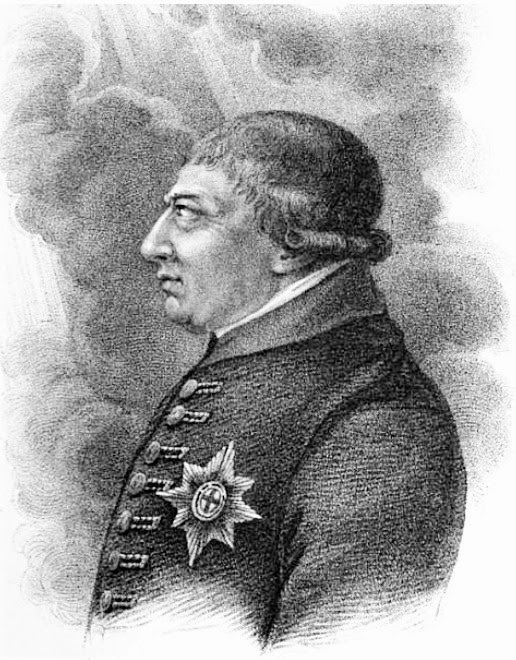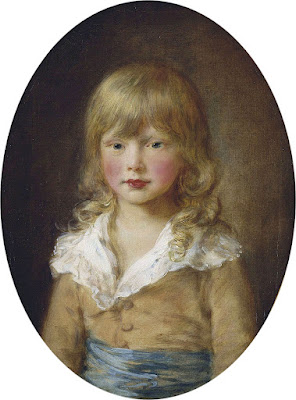Prince Octavius (23 February 1779 - 3 May 1783) was the beloved 13th child and 8th son of George III and Queen Charlotte who died in infancy.
“The finest boy of the royal offspring”
Octavius was born at Buckingham House on 23 February 1779 and was christened on 23 March in the great council chamber at St James’ Palace by the Archbishop of Canterbury.
George III was extremely fond of Octavius who was a very docile and good-natured child – “the finest boy of the royal offspring.”2
“The finest boy of the royal offspring”
Octavius was born at Buckingham House on 23 February 1779 and was christened on 23 March in the great council chamber at St James’ Palace by the Archbishop of Canterbury.
George III was extremely fond of Octavius who was a very docile and good-natured child – “the finest boy of the royal offspring.”2
He was a very pretty child with long golden curls and bright blue eyes, and was particularly close to the sister nearest to him in age, Princess Sophia, who called him “her son.”
 |
| Princess Sophia from A Biographical Memoir of Frederick, Duke of York and Albany by John Watkins (1827) |
When he was four years old, Octavius was inoculated against the smallpox. Queen Charlotte was an advocate of inoculation, where people were deliberately brought into contact with the virus in order to give them lasting protection against the highly contagious disease.
Inoculation carried the risk of the person contracting a serious case of smallpox, but the risk of death from the disease itself was much greater. The much safer preventative measure of cowpox vaccination was not discovered by Edward Jenner until 1796.
Octavius’ death
Sadly, Octavius became ill after being inoculated and died of smallpox at Kew Palace on 3 May 1783. At about 3am on 10 May, Octavius’ body was taken to Westminster Abbey, accompanied by the Earl of Hertford, where the body was deposited in the royal vault.
On 11 February 1820, his coffin was transferred to the Royal Vault in St George’s Chapel, Windsor.
A King in mourning
 |
| George III from Memoirs of HM Sophia Charlotte of Mecklenburg Strelitz, Queen of Great Britain by William Marshall Craig (1818) |
There was no formal mourning for his death because of his age. One source suggests that this was because he was under 7; another suggests that it was because he was under the age of 14.
The King was devastated, declaring:
The King was devastated, declaring:
There will be no heaven for me if Octavius is not there.3Octavius’ likeness was taken by Gainsborough in 1782. It was completed after his death and drew much public attention when it was exhibited.
Rachel Knowles writes clean/Christian Regency era romance and historical non-fiction. She has been sharing her research on this blog since 2011. Rachel lives in the beautiful Georgian seaside town of Weymouth, Dorset, on the south coast of England, with her husband, Andrew.
Find out more about Rachel's books and sign up for her newsletter here.If you have enjoyed this blog and want to encourage me and help me to keep making my research freely available, please buy me a virtual cup of coffee by clicking the button below.
Notes
- Prince Octavius by Thomas Gainsborough, Public Domain via Wikimedia Commons.
- Oulton, Walley Chamberlain, Authentic and Impartial Memoirs of Her Late Majesty Charlotte, Queen of Great Britain and Ireland (1819).
- Hibbert, Christopher, George IV (1972, 1973 ).
Sources used include:
Bissett, Robert, The History of the Reign of George III (1822)
Chedzoy, Alan, Seaside Sovereign - King George III at Weymouth (2003)
Craig, William Marshall, Memoirs of HM Sophia Charlotte of Mecklenburg Strelitz, Queen of Great Britain (1818)
Hibbert, Christopher, George IV (1972, 1973 )
Oulton, Walley Chamberlain, Authentic and Impartial Memoirs of Her Late Majesty Charlotte, Queen of Great Britain and Ireland (1819)
Bissett, Robert, The History of the Reign of George III (1822)
Chedzoy, Alan, Seaside Sovereign - King George III at Weymouth (2003)
Craig, William Marshall, Memoirs of HM Sophia Charlotte of Mecklenburg Strelitz, Queen of Great Britain (1818)
Hibbert, Christopher, George IV (1972, 1973 )
Oulton, Walley Chamberlain, Authentic and Impartial Memoirs of Her Late Majesty Charlotte, Queen of Great Britain and Ireland (1819)



No comments:
New comments are not allowed.